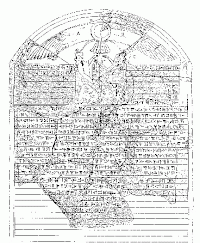DZ
Achaemenid Royal Inscriptions: collection of Old Persian cuneiform texts from the sixth, fifth, and fourth centuries BCE, left by the Achaemenid kings on their official monuments.
Darius' Suez Inscriptions

The following three texts are part of a stela of pink granite that was discovered in 1866, by Charles de Lesseps, near Kabret, 130 kilometers from Suez. The upper part shows the Persian king Darius the Great (twice), flanking a cartouche with his name (DZa). To the left and right is inscription DZb; at his feet is DZc, written in ancient Persian and Elamite; the reverse of the stone gives the same text - with some extra details - in Egyptian. The first two texts resemble DNa.

The monument, also known as the "Chalouf Stele", documents the construction of a canal that connected the river Nile to the Red Sea. The project, undertaken by king Darius in c.515-c.495 BCE, may not have been the first of its kind: it is possible that the rulers of the New Kingdom had already dug a canal like this, although hard evidence is missing. The list of places mentioned in the biblical book of Exodus as the route of the Jews leaving Egypt, resembles the general direction of the canal. But although Darius may have merely restored an older water course, the project itself was very important, because it facilitated trade between the Nile, Red Sea, and Persian Gulf.
There were older canals (e.g., by Ramesses II) and the canal remained in us. In the Early Middle Ages, it was used to transport food from Egypt to Mecca.
DZa (cartouche)
- Dârayavauš
Darius
DZb (signature)
- Dârayavauš \ XŠ \ vazraka
- \ XŠ : XŠyânâm \ XŠ \ dahy
- ûnâm \ XŠ \ ahyâyâ \
- bumiyâ \ vazrakâyâ \
- Vištâspahyâ \ pu
- ça\ Haxâmanišiya
Darius the great king, king of kings, king of all nations, king in this great earth, son of Hystaspes, an Achaemenid.
DZc (Canal Inscription)

- baga \ vazraka \ Auramazdâ \ hya \ avam \ asmânam \ adâ \ hya \ imâm \ bum
- im \ adâ \ hya \ martiyam \ adâ \ hya \ šiyâtim \ adâ \ martiyahy
- â \ hya \ Dârayavaum \ XŠyam \ akunauš \ hya \ Dârayavahauš \ XŠyâ \xšaça
- m \ frâbara \ tya \ vazrakam \ tya \ uvaspam \ umartiyam \ adam \ Dârayavauš \
- XŠ \ vazraka \ XŠ \ Xšyânâm \ XŠ \ dahyunâm \ vipazanânâm \ XŠ \ ahyây
- â \ bumiyâ \ vazrakâyâ \ dûraiy \ apiy \ Vištâspahyâ \ puça \ Ha
A great god is Ahuramazda, who created yonder sky, who created this earth, who created man, who created happiness for man, who made Darius king, who bestowed on Darius a great kingdom with good horses and good people.
I am Darius the great king, king of kings, king of all kinds of men, king in this great earth far and wide, son of Hystaspes, an Achaemenid.

- xâmanišiya \ thâtiy \ Dârayavauš \ XŠ \ adam \ Pârsa \ amiy \ hacâ \ Pâ
- rsâ \ Mudrâyam \ agarbâyam \ adam \ niyaštâyam \ imâm \ yauviyâ
- m \ katanaiy \ hacâ \ Pirâva \ nâma \ rauta \ tya \ Mudrâyaiy \ danuvatiy \ ab
- iy \ draya \ tya \ hacâ \ Pârsâ \ aitiy \ pasâva \ iyam \ yauviyâ \ akaniya \
- avathâ \ yathâ \ adam \ niyaštâyam \ utâ \ nâva \ âyatâ \ hacâ \ Mudrâ
- yâ \ tara \ imâm \ yauviyâm \ abiy \ Pârsam \ avathâ \ yathâ \ mâm \ kâma\ âha
King Darius says: I am a Persian; setting out from Persia, I conquered Egypt.note I ordered to dig this canal from the river that is called Nilenote and flows in Egypt, to the sea that begins in Persia. Therefore, when this canal had been dug as I had ordered, ships went from Egypt through this canal to Persia, as I had intended.
Literature
- Carol A. Redmount, "The Wadi Tumilat and the 'Canal of the Pharaohs'", in: Journal of Near Eastern Studies, 54/2 (1995) 127-135